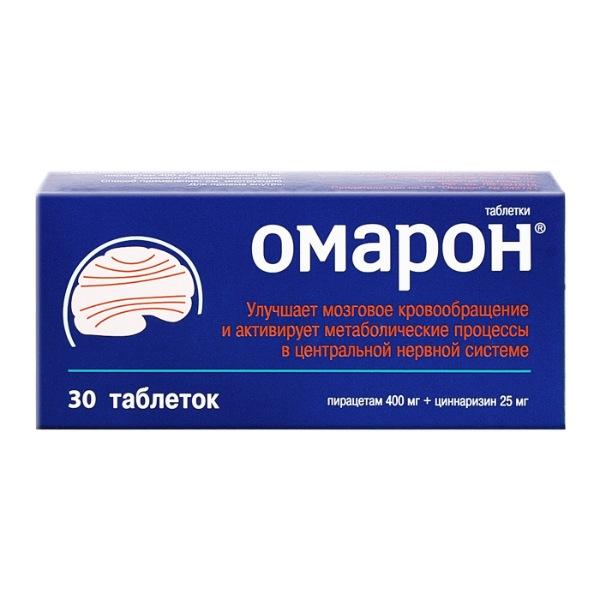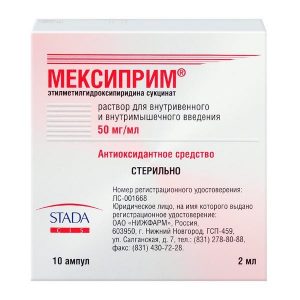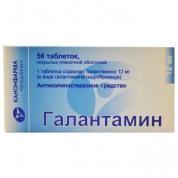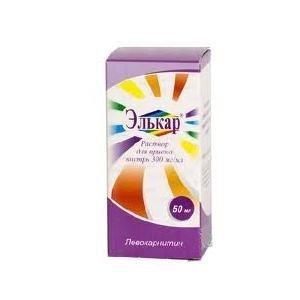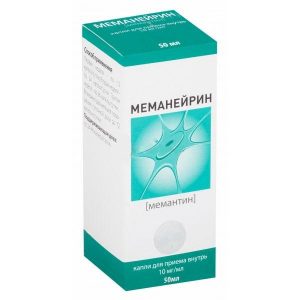Description
Release form
Tablets 400 mg + 25 mg.
10 tablets per blister strip packaging made of polyvinyl chloride film and varnished aluminum printed foil.
3, 6 or 9 blister packs along with instructions for medical use of the drug are placed in a pack of cardboard.
Packing
30 pcs.
Pharmacological action
Combined drug with a pronounced antihypoxic, nootropic and vasodilating effect.
Piracetam activates metabolic processes in the brain by enhancing energy and protein metabolism, accelerating the utilization of glucose by cells and increasing their resistance to hypoxia improves interneuronal transmission in the central nervous system, improves regional blood flow in the ischemic zone.
Cinnarizine – a selective blocker of “slow” calcium channels, reduces the intake of calcium ions into cells and reduces its content in the plasma membrane depot, reduces the tone of smooth muscles of arterioles, reduces their response to biogenic vasoconstrictors (adrenaline, norepinephrine, dopamine, angiotensin II, vasopressin, serotonin). It has a vasodilating effect (especially in relation to cerebral vessels, enhancing the antihypoxic effect of piracetam), without having a significant effect on blood pressure. It exhibits moderate antihistamine activity, reduces the excitability of the vestibular apparatus, and lowers the tone of the sympathetic nervous system. Increases the elasticity of erythrocyte membranes, their ability to deform, reduces blood viscosity.
Suction. After oral administration, piracetam and cinnarizine are rapidly and almost completely absorbed in the gastrointestinal tract. The bioavailability of piracetam is about 100%. The maximum concentration (Cmax) of piracetam is reached in 0.5-1 hours after administration. The maximum concentration of cinnarizine in plasma is achieved after 1-3 hours. The bioavailability of cinnarizine increases in an acidic environment.
distribution. Piracetam does not bind to plasma proteins. The volume of distribution is about 0.6 l / kg. It penetrates the blood-brain and placental barriers, into all organs and tissues, as well as through the filtering membranes used in hemodialysis. In animal studies, it was found that piracetam selectively accumulates in the tissues of the cerebral cortex, mainly in the frontal, parietal and occipital lobes, cerebellum and basal ganglia.
Cinnarizine. Communication with plasma proteins is 91%. 1-4 hours after ingestion is detected in the liver, kidneys, heart, lungs, spleen and brain.
Metabolism. Piracetam is practically not metabolized in the body.
Cinnarizine is actively and completely metabolized by dealkylation, the metabolic process begins 30 minutes after ingestion.
Withdrawal. Piracetam More than 95% of the oral dose is excreted by the kidneys unchanged by renal filtration for 30 hours. The renal clearance of piracetam in healthy volunteers is 86 ml / min. The elimination half-life (T1 / 2) is 4-5 hours from blood plasma and 8.5 hours from cerebrospinal fluid. In patients with renal failure, T1 / 2 lengthens. In patients with hepatic insufficiency, the pharmacokinetics of piracetam does not change.
Cinnarizine is excreted in the form of metabolites (1/3 – by the kidneys, 2/3 – through the intestines), T1 / 2 – about 4 hours.
Indications
Diseases of the central nervous system, accompanied by a decrease in intellectual-mnestic functions.
As part of complex therapy: cerebrovascular insufficiency (cerebral arteriosclerosis, recovery period after ischemic and hemorrhagic stroke) encephalopathy post-toxic or post-traumatic depression psycho-organic syndrome with a predominance of signs of asthenia and adynamia vestibular disorders Meniere’s syndrome intellectual developmental lag in children prevention of migraine prevention of kinetosis in adults and children.
Contraindications
Hypersensitivity to the main and / or auxiliary components of the drug severe liver failure severe renal failure (creatinine clearance less than 20 ml / min) hemorrhagic stroke parkinsonism (including Parkinson’s disease) psychomotor agitation lactation period infant pregnancy 5 years lactose intolerance, lactase deficiency, glucose-galactose malabsorption syndrome (the drug contains lactose).
Precautions
Diseases of the liver and / or kidneys, chronic renal failure (creatinine clearance 20-80 ml / min) increased intraocular pressure porphyria hemostasis disorder extensive surgery heavy bleeding hyperthyroidism epilepsy pronounced atherosclerosis of the brain vessels prone to neurotic reactions.
Use during pregnancy and lactation
The drug is contraindicated in pregnancy and lactation (breastfeeding).
Special instructions
For prolonged use, monitoring of liver and kidney function is recommended (especially in patients with chronic renal failure).
During treatment, patients with arterial hypotension may experience a more significant decrease in blood pressure.
Alcohol is not recommended during treatment.
Possible distortion of the results of a doping test and allergic skin tests 4 days before the study, the drug should be discontinued.
Effect on the ability to drive vehicles and control mechanisms
During treatment, care must be taken when driving vehicles and engaging in other potentially hazardous activities that require increased concentration of attention and speed of psychomotor reactions.
Composition
Active ingredients: piracetam 400 mg cinnarizine 25 mg
excipients: lactose monohydrate 23.5 mg magnesium hydroxycarbonate pentahydrate 46.8 mg povidone (collidone 30) 3.9 mg silicon colloidal dioxide (Aerosil A-380) 5 2 mg, calcium stearate monohydrate 5.2 mg crospovidone (Collidone CL-M) 10.4 mg.
Dosage and Administration
Inside, during or after a meal.
Adults: 1-2 tablets 3 times a day for 1-3 months, depending on the severity of the disease. It is possible to conduct repeated courses of treatment – 2-3 times a year.
Children over 5 years: 1-2 tablets 1-2 times a day. Do not use for more than 3 months.
For the prevention of kinetosis: in adults – 1 tablet, in children over 5 years – 1/2 tablet 30 minutes before the start of the trip, with a second dose (if necessary) every 6-8 hours.
Patients with impaired renal function: in case of chronic renal failure (creatinine clearance 20-80 ml / min) – 1 tablet 2 times a day.
Side effects of
From the central and peripheral nervous system: motor disinhibition, irritability, sleep pain, asthma. In isolated cases, dizziness, ataxia, exacerbation of epilepsy, extrapyramidal disorders, tremor, imbalance, decreased ability to concentrate, insomnia, agitation, anxiety, hallucinations, increased sexuality are noted.
From the cardiovascular system: decrease or increase in blood pressure.
From the digestive system: dyspeptic symptoms, a feeling of dry mouth in isolated cases – nausea, vomiting, diarrhea, abdominal pain, cholestatic jaundice.
From the skin: in isolated cases, dermatitis, itching, skin rash.
Metabolism: weight gain.
Allergic reactions: angioedema.
Other: increased sweating in isolated cases – lupus-like syndrome, lichen planus.
Drug interaction
With simultaneous use, it is possible to enhance the sedative effect of drugs that inhibit the activity of the central nervous system, as well as ethanol, nootropic and antihypertensive drugs.
Vasodilating agents enhance the effect of the drug.
Improves tolerance to antipsychotic drugs and tricyclic antidepressants.
With the simultaneous use of piracetam enhances the central effects of thyroid hormones (tremors, anxiety, irritability, sleep disturbances are possible) may enhance the effect of oral anticoagulants.
Overdose
Symptoms of overdose due mainly to m-cholin-blocking activity of cinnarizine include: disorders of consciousness, vomiting, extrapyramidal symptoms, decrease in blood pressure. Following oral administration of piracetam at a dose of 75 g, diarrhea with blood and abdominal pain were observed.
Treatment: No specific antidote exists. In case of overdose, gastric lavage and activated charcoal administration, symptomatic and supportive therapy are required. The effectiveness of hemodialysis for piracetam is 50-60%.
Storage Conditions
The product should be stored out of reach of children, in a dry, dark place at a temperature not exceeding 25 ° C.
Shelf life
3 years. Do not use after the expiration date indicated on the package.
Deystvuyushtee substance
Piracetam, Tsinnarizin
Pharmacy terms
Prescription
Dosage form
tablets
Possible product names
OMARON N30 TABLE
30mrd 30mbr 30mrd 30gmrd 30ml OMARON TAB. 400 MG + 25MG No. 30
Omaron tab. X30
Nizhpharm, Russia
